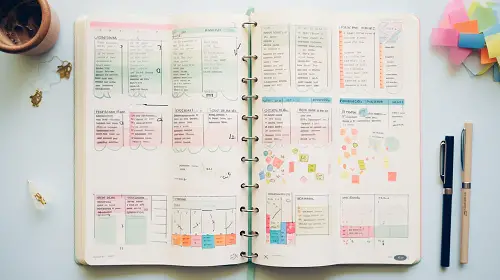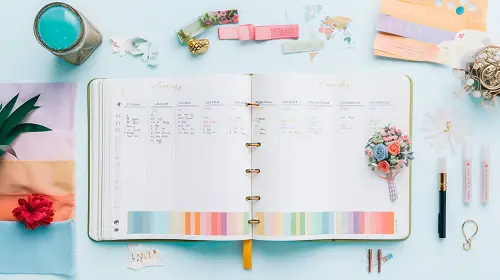Are you looking for a creative and flexible way to stay organized, boost productivity, and unleash your creativity? Look no further than bullet journaling. This popular method of planning, tracking, and journaling has taken the world by storm, offering an innovative and customizable approach to organizing your life. In this beginner’s guide, we will explore the fundamentals of bullet journaling and provide you with the knowledge and inspiration to start your own bullet journaling journey.
What is Bullet Journaling?
Bullet journaling is a method of journaling and planning that combines to-do lists, calendars, trackers, and personal reflections into one concise and organized system. Developed by designer Ryder Carroll, the bullet journaling method revolves around rapid logging, using bullets, symbols, and short phrases to record and organize information.
Getting Started: Essential Supplies
To begin your bullet journaling journey, you’ll need a few basic supplies:
- Notebook: Choose a notebook that suits your preferences. Look for ones with dot grid or grid paper, as they provide flexibility for creating layouts.
- Pens: Invest in a set of quality pens with various tip sizes for different tasks. Popular choices include fineliners, gel pens, and brush pens.
- Ruler: A ruler will come in handy for creating straight lines and grids in your journal.
- Optional Supplies: Colored markers, highlighters, stickers, washi tape, and other decorative elements can add flair to your bullet journal.
Core Components of a Bullet Journal
1. Index
The index is like the table of contents for your bullet journal. Number your pages and keep track of the contents in your index. This way, you can easily find important information later on.
2. Future Log
The future log is a year-at-a-glance overview where you can jot down important dates, events, and goals for the upcoming months. It helps you plan ahead and ensures you don’t miss any important deadlines.
3. Monthly Log
The monthly log is where you can organize your tasks, events, and goals for each month. Use a calendar format to log important dates and create a task list for the month.
4. Daily Log
The daily log is the heart of your bullet journal. Here, you can record your tasks, events, and notes for each day. The beauty of the bullet journaling method is that it allows you to customize your daily log based on your needs and preferences.
- Rapid Logging: Use symbols to represent different types of tasks. For example, an open circle can represent tasks, a dot can represent notes, and an arrow can represent events.
- Migration: At the end of each day or month, review your tasks and migrate any unfinished ones to the next day or month. This helps you prioritize and ensures important tasks don’t fall through the cracks.
5. Collections
Collections are pages dedicated to specific topics or themes. They can include habit trackers, gratitude lists, book logs, meal plans, travel itineraries, and more. Collections allow you to organize and track information beyond your daily and monthly logs.
6. Reflection
Take time to reflect on your bullet journal periodically. Review your accomplishments, challenges, and experiences. Use this space to write down personal reflections, lessons learned, or future intentions. Reflection can provide valuable insights and help you grow personally and professionally.
Tips for Effective Bullet Journaling
- Start Simple: Don’t overwhelm yourself with complex layouts and designs at the beginning. Start with a basic setup and gradually add more elements as you become comfortable with the process.
- Experiment and Adapt: One of the joys of bullet journaling is its flexibility. Feel free to experiment with different layouts, trackers, and collections. Adapt your journal to suit your evolving needs and preferences.
- Stay Consistent: Consistency is key in bullet journaling. Make it a habit to update your journal daily and review it regularly. The more consistently you use your bullet journal, the more effective it will become.
- Embrace Imperfections: Remember, your bullet journal is a reflection of your unique journey. Embrace imperfections and don’t be afraid to make mistakes. It’s all part of the creative process.
Frequently Asked Questions (FAQ)
Q1: Do I have to be artistic or creative to start a bullet journal?
Absolutely not! While some bullet journalers enjoy adding artistic elements and decorative touches, it is not a requirement. Bullet journaling is about personal organization and reflection, so focus on functionality and create a journal that works for you.
Q2: Can I use a pre-made journal or a digital app for bullet journaling?
Yes, you can use pre-made journals that already have bullet journaling elements or opt for digital bullet journaling appsthat provide a similar experience. The key is to find a format that suits your needs and preferences.
Q3: How can bullet journaling help with productivity and time management?
Bullet journaling enhances productivity and time management by allowing you to prioritize tasks, set goals, and track progress. With the use of monthly, weekly, and daily logs, you can easily organize your to-do lists and stay focused on what matters most.
Q4: Can I use a bullet journal for specific purposes, such as fitness or budgeting?
Absolutely! Bullet journals are highly adaptable and can be customized to serve various purposes. You can create dedicated collections for fitness tracking, budget planning, meal planning, or any other area you want to focus on.
Q5: What are some sources of inspiration for bullet journaling?
There are numerous sources of inspiration for bullet journaling. Explore social media platforms like Instagram and Pinterest, where you can find a wealth of ideas, layouts, and creative designs shared by the bullet journaling community. You can also draw inspiration from nature, books, magazines, and your own personal experiences.
Conclusion
Bullet journaling offers a unique and personalized approach to organization and self-reflection. With its flexibility and adaptability, it is no wonder that so many people have embraced this method of planning and journaling. Remember, the key to successful bullet journaling is finding a system that works for you and enjoying the creative process along the way. So grab a notebook, some pens, and start designing your own bullet journal today. Happy journaling!



